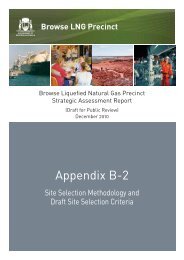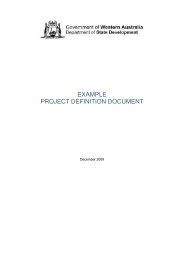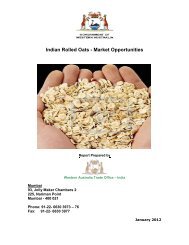Browse LNG Precinct - Public Information Booklet - Department of ...
Browse LNG Precinct - Public Information Booklet - Department of ...
Browse LNG Precinct - Public Information Booklet - Department of ...
Create successful ePaper yourself
Turn your PDF publications into a flip-book with our unique Google optimized e-Paper software.
<strong>Public</strong> <strong>Information</strong> <strong>Booklet</strong><br />
resume normal behaviour patterns and return to the area once the sediment settles.<br />
Once dredging ceases, the time taken for sediment to settle depends on the ocean<br />
conditions and the sediment size, however is not likely to be more than 24 hrs.<br />
Some sea life such as seagrass, algae etc are potentially at risk <strong>of</strong> smothering as<br />
sediment settles from a dredge plume. The environmental impact assessment will<br />
increase our understanding <strong>of</strong> the areas likely to be impacted and the level <strong>of</strong> impact.<br />
Question - What is the policy regarding the removal <strong>of</strong> clam and trumpet shells?<br />
Will efforts be made to re-locate them?<br />
Efforts will be made to understand the likely presence <strong>of</strong> clams, trumpet shells and other<br />
species <strong>of</strong> concern in the area through the marine studies and environmental impact<br />
assessment, and in consultation with Traditional Owners. Based on an understanding <strong>of</strong><br />
the distribution <strong>of</strong> these animals and the likely area to be effected, an assessment can be<br />
made on the likely impact from any losses <strong>of</strong> individuals within this population. It is<br />
anticipated that the proportion <strong>of</strong> habitat that will be lost relative to the available suitable<br />
habitat will be minimal. However, through the impact assessment we intend to<br />
understand where the critical habitats occur and minimise impacts to these locations.<br />
The ability to relocate individual shells will be severely restricted and currently would not<br />
be considered likely because:<br />
� it will be difficult to locate individual shells in the construction area;<br />
� it will be unsafe to work anywhere near the dredging activities to collect the shells;<br />
� shell collection would require diving which is also a dangerous activity that is<br />
avoided wherever possible; and<br />
� the populations are anticipated to be widespread in the area and therefore resilient<br />
in relation to any direct losses <strong>of</strong> individuals in the <strong>LNG</strong> <strong>Precinct</strong> port area.<br />
Commitments to minimise impacts on clams and trumpet shells can be picked up in either<br />
the environmental and/or cultural heritage management plans that will be included as part<br />
<strong>of</strong> the ILUA (or ILUAs) for the <strong>Precinct</strong> and/or proponentís project.<br />
Question ñ What <strong>of</strong>fshore drilling is required for the jetty?<br />
Drilling for the jetty will be required firstly to understand the marine geology (material<br />
type) via geotechnical surveys (drilling and other ground studies) and then secondly to<br />
install the piles for the jetty.<br />
The geotechnical investigations for the marine works, including the jetty, will be<br />
conducted in a particular order. Firstly, this will require drilling to understand foundation<br />
conditions. This will involve drilling several bore holes to build an early understanding <strong>of</strong><br />
the geology/ground conditions. Once the initial understanding is obtained a more<br />
detailed and thorough investigation will be required. The exact number bore holes to be<br />
drilled is not yet finalised, but is likely to be between 20 and 40 holes. Depending on the<br />
results <strong>of</strong> these drill holes, additional drilling may be required for design purposes.<br />
5279225 61









